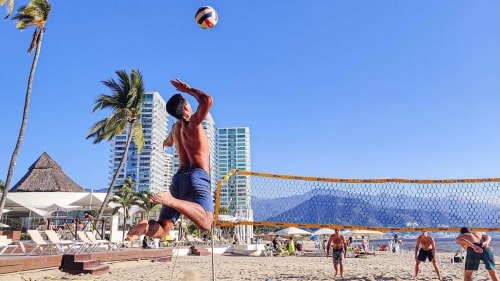How To Jump Higher In Volleyball

A powerful and explosive jump can give you an advantage over your opponents, allowing you to spike the ball with greater force and reach higher blocks. In this article, we will explore how to jump higher in volleyball and take your volleyball game to new heights.
Proper Warm-up and Stretching
Before engaging in any physical activity, it’s essential to warm up your body and stretch your muscles. A dynamic warm-up routine consisting of exercises like high knees, butt kicks and leg swings helps increase blood flow and prepares your muscles for the demands of jumping.
Additionally, incorporating stretching exercises for the lower body, such as hamstring stretches and calf stretches, can improve flexibility and reduce the risk of injury.
Building Leg Strength
Building leg strength is paramount when it comes to jumping higher in volleyball. Exercises like squats, lunges and calf raises are highly effective in developing the muscles required for explosive jumps. Squats, including variations like front squats and goblet squats, target the quadriceps, hamstrings and glutes.
Lunges and split squats work the leg muscles unilaterally, promoting balance and stability. Calf raises, both with bodyweight and added resistance, strengthen the calf muscles, aiding in generating power during jumps.
Plyometric Training
Plyometric training is a powerful method for improving vertical jump height. By incorporating explosive jumping exercises into your training routine, you can increase your muscle power and enhance your jump. Box jumps, depth jumps, squat jumps and tuck jumps are excellent examples of plyometric exercises that can boost your jumping ability.
These exercises focus on quick and forceful muscle contractions, training your muscles to generate more power during jumps.
Core Strength and Stability
A strong core is essential for maintaining balance and stability during jumps. Core exercises like planks, Russian twists and leg raises target the abdominal and lower back muscles, improving overall body control. By strengthening your core, you can maximize the transfer of power from your lower body to your upper body during a jump, resulting in higher vertical height.
Technique and Form
Having proper technique and form is crucial for maximizing your jump height. Pay attention to your approach and take off, ensuring that you have a strong and explosive push off from both feet. Additionally, focus on your arm swing, using it to generate upward momentum. Lastly, perfect your landing technique by bending your knees upon landing to absorb the impact and maintain balance.
Jumping Drills and Practices
Incorporating specific jumping drills and practices into your training routine is an effective way to improve your jumping ability. Vertical jump training programs, such as the “Vert Shock” program, provide structured exercises and progressions to enhance your vertical height.
It’s also beneficial to integrate jump training into your volleyball practices, incorporating drills like spike approaches and block jumps. By tracking your progress and setting goals, you can monitor your improvement over time.
Recovery and Injury Prevention
Proper recovery and injury prevention techniques are essential when engaging in intense jump training. Allow your body enough time to rest and recover between training sessions to avoid overuse injuries. Stretching and foam rolling can help alleviate muscle soreness and prevent tightness.
Additionally, incorporating injury prevention exercises that target the ankles, knees and hips can reduce the risk of common jumping related injuries.
Nutrition and Hydration
Optimal nutrition and hydration play a significant role in improving athletic performance, including jump height. Ensure you maintain a balanced diet rich in lean proteins, complex carbohydrates and healthy fats to provide your body with the necessary fuel for intense workouts.
Staying hydrated before, during and after training sessions is also crucial for optimal muscle function and performance. Consider consuming a mix of carbohydrates and protein before and after workouts to aid in muscle recovery and growth.
Mental Preparation
Jumping higher in volleyball not only requires physical preparation but also mental fortitude. Visualizing success and mentally rehearsing successful jumps can help improve your confidence and performance. Engage in positive self talk, reminding yourself of your abilities and achievements. Overcoming the fear of jumping and embracing the challenge will enable you to push past your limits and achieve greater heights.
Common Mistakes to Avoid
While working on improving your jumping ability, it’s important to be aware of common mistakes that can hinder progress. Rushing the approach, neglecting strength training and having poor landing technique are common pitfalls to avoid. Take your time to develop proper technique, incorporate strength training exercises into your routine and focus on landing with control to maximize the effectiveness of your jumps.
Conclusion
Improving your jumping ability in volleyball is a journey that requires dedication, proper training and a focused mindset. By following these five expert tips, you can enhance your vertical jump, increase your spiking power and become a more valuable asset to your volleyball team.
Remember to prioritize warm-up and stretching, build leg strength, incorporate plyometric training, strengthen your core, focus on technique and integrate jump specific drills into your training routine. With consistent effort and perseverance, you’ll be reaching new heights in no time.


